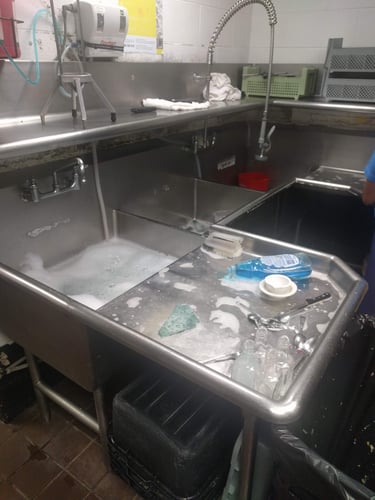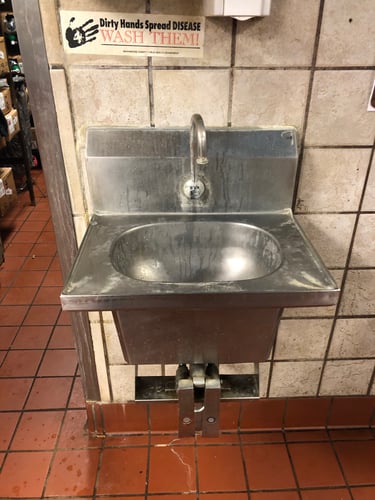Welcome to another 86 Repairs Guide! In this series, we provide valuable data and maintenance and troubleshooting information for the equipment and infrastructure found in your restaurant. We hope this information will help you and your team become more informed about repairs and maintenance (R&M)—and save you time and money along the way.
Restaurants can be cutthroat. Competition is fierce, margins are tight, and spare time—along with customer patience—is minimal. It takes a special kind of person to be able to thrive in that environment.
Let’s just say that, in most industries, you either sink or swim—but in restaurants, you actually need the sinks to be able to swim! 🏊
So in this Guide, we’re taking a deep dive into restaurant sinks, how to maintain them, and how to troubleshoot their most common issues without calling in a vendor for service.
Table of Contents
What is a restaurant sink?
Restaurants need various types of sinks throughout their four walls to keep service flowing:
- Bar sinks, which are used to prep drinks and empty glassware before it’s stacked and sent to a dishwashing station
- Hand sinks that staff use to wash up after handling food or personal items
- Compartment sinks, used for food prep, food scraps, and washing dishes. While the number of compartments may vary, health departments typically require three-compartment sinks in restaurants.
- Mop sinks specifically meant to dump or rinse cleaning supplies (such as, you guessed it, mops)
- Bathroom sinks so customers and staff alike can wash up after doing their (private) business.
The number and type of sinks in your restaurant will vary depending on its size, type of service, and local health codes. Without proper maintenance, repairs to these sinks could really drain your R&M budget.
Numbers to know about restaurant plumbing
86 Repairs collects data from every service call our customers submit to give operators a better idea of what they’ll spend on repairs. We include all restaurant sink requests within our general plumbing category.
On average, our restaurant customers spent $592.80 in 2022 for each plumber visit. Only 8% of those plumbing problems had to be resolved with multiple vendor visits.
But with proper maintenance, common restaurant sink issues can mostly be prevented.

Routine maintenance for restaurant sinks
Restaurant sink maintenance should only take teams a few minutes to complete every day. And when you consider the downtime and extra expenses that could be associated with a broken sink, those extra minutes are a worthwhile investment.
First thing’s first: check that every sink has hot water and is stocked with soap. Your health inspection score depends on it! Even sinks that don’t see a lot of action should have hot water run through them a few times weekly to eliminate fumes and reduce the chance the line will dry up.
At close, staff should be cleaning every sink drain to help avoid fruit flies and mold growth. Never use bleach to do this; it can damage stainless steel pipes. Any sink that is used to discard beverages or food should be cleaned with a drain sanitizer or bio-enzymatic cleaner to break down buildup. After a rinse, the drains can be covered with rocks glasses or simple plastic wrap to avoid fruit flies coming into the restaurant.
Outfit sinks that see a lot of debris with fine mesh colanders or other straining contraptions to protect the pipes. Food and garnishes should never go directly down any of your sinks—they’ll clog your plumbing and create a breeding ground for those pesky fruit flies.
Preventative maintenance for restaurant sinks
Routine maintenance can stop the frequency and severity of common sink issues—but it’s not a failsafe. For additional coverage, we recommend plumbing preventative maintenance twice per year at each restaurant you run.
During a preventative maintenance call, your plumber will clean and examine the pipes that lead from your sinks to the rest of your plumbing system, like:
- P-traps—the curved pipes under sinks that create a seal that keeps fumes from leaking into the restaurant
- Drain lines—a plumber can get below the point where a spatula or metal snake could reach to break up clogs
Line jetting is another important component of plumbing preventative maintenance. Grease and grime cause the restaurant pipes to get narrow over time, which will cause the entire system to slow down and create complicated clogs. During line jetting, those layers of debris are removed so your staff can keep going with the flow.
Read The 86 Repairs Guide to Restaurant Grease Traps for more information about line jetting.
Want to know your next line of defense against sinking money into vendor visits? Troubleshooting!

Restaurant sink troubleshooting tips
Try resolving the most common restaurant sink issues with in-house troubleshooting. Roll up your sleeves and dive in with these tips!
Clogged sink drain
Lots of funky stuff winds up down restaurant sinks. Leftover sugary drinks that grow mold; dirty cloth napkins that were accidentally shoved down the drain. As a result, clogs are extremely common.
Think you have a clogged sink? Try:
- Checking for large debris. Any large items (like that dirty cloth napkin) should be fished out with a utensil.
- Using a drain snake to attempt to loosen up the line from any debris further into the pipe.
- Plunging the sink if the drain snake doesn’t remove the clog.
- Using a wet or bucket vac as a final step to remove water and attempt to suck the clog out of the drain.
If the sink drain is still clogged after following those four steps, call in a professional for help.
Sink leak
Restaurant sinks are already a bit wet and wild. Leaks not only make sink areas even messier, but they also waste water! In an industry where every dollar matters to stay profitable, you need to eliminate as much of that waste as possible.
Identify the source of the sink leak, and proceed accordingly:
Leak from hose or pipe
- If water is also backed up into the sink, the pipe could be clogged. Follow the “Clogged sink drain” guidance above.
- Verify every connection point between the hose or pipe and water source is solid.
- Disconnect and clean any connector that has sediment. Then, reconnect the line.
- Any connector that does not have sediment should be tightened.
- If there’s no clog and all connections are clean and tight, the leak could be coming from a cracked pipe. Painter’s tape or putty can be used in a pinch until a plumber is dispatched for service.
Leak from manual faucets
- Verify the water supply under the sink is turned on.
- Verify every connection point between the hose or pipe and water source is solid.
- Verify the connection of each handle.
- Remove and clean handles with sediment. Then, reconnect the handle.
- Any handle without buildup should be tightened.
If a faucet leak is still present, the sink could have a failed cartridge. Have a facility manager on your staff? They can take a look and potentially replace it instead of calling in a specialist.
Leak from automatic faucets
- Verify the water supply under the sink is turned on.
- Verify the faucet sensors are on. If they’re not working, try replacing their batteries.
- Remove buildup from faucet sensors.
- Check the sink’s user manual for other specific troubleshooting guidance before seeking help from a plumber.
Odor present
They’re called restaurant sinks, not restaurant stinks. If any unpleasant odors are coming up out of your sinks,
- Remove clogs using the “Clogged sink drain” troubleshooting tips above.
- No clogs? Could be a dry p-trap.
- Use a cleaning solution to flush the sink and pipe of any residue.
- Fill the p-trap reservoir with water.
If an odor is still present, a plumber needs to take a look.
A final note on restaurant sinks
Restaurant sink issues don’t have to drain your R&M budget. With simple routine maintenance, ongoing preventative maintenance, and easy in-house troubleshooting, repair-related expenses can be kept to a minimum.